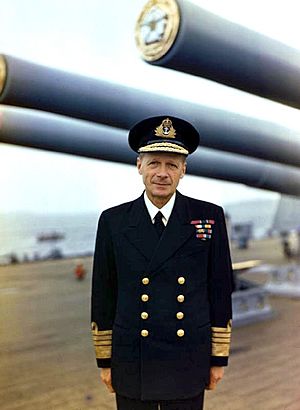Henry Ruthven Moore facts for kids
Quick facts for kids
Sir Henry Moore
|
|
|---|---|

Admiral Moore under the guns of his flagship HMS Duke of York at Scapa Flow
|
|
| Born | 29 August 1886 Plumstead, Kent |
| Died | 12 March 1978 (aged 91) Wateringbury, Kent |
| Allegiance | |
| Service/ |
|
| Years of service | 1902–1950 |
| Rank | Admiral |
| Commands held | HMS Caradoc HMS Dauntless HMS Neptune Home Fleet Nore Command |
| Battles/wars | World War I World War II |
| Awards | Knight Grand Cross of the Order of the Bath Commander of the Royal Victorian Order Distinguished Service Order Mentioned in Despatches Legion of Merit (United States) |
Admiral Sir Henry Ruthven Moore GCB, CVO, DSO (born August 29, 1886 – died March 12, 1978) was a very important British naval officer. He was the last admiral to lead the Home Fleet during World War II. The Home Fleet was a major part of the Royal Navy that protected the waters around Britain. Sir Henry Moore was in charge of this powerful fleet from 1944 to 1945, helping to guide the navy through the final years of the war.
Contents
Early Years and World War I
Henry Moore was born in Plumstead, Kent, in 1886. He went to Sherborne School before joining the Royal Navy in 1902. This was the start of his long and impressive career at sea.
He served in World War I, which lasted from 1914 to 1918. During this time, he took part in the famous Battle of Jutland in 1916. This was one of the biggest naval battles in history.
Leading Ships and Fleets
After World War I, Moore continued to rise through the ranks. From 1928 to 1930, he commanded two cruisers: HMS Caradoc and HMS Dauntless. A cruiser is a type of fast warship.
In 1933, he took command of another cruiser, HMS Neptune. He then became a Chief of Staff for the Home Fleet in 1936. This meant he helped plan and organize the fleet's operations.
World War II Commander
Sir Henry Moore played a key role in World War II. He started as the Commander of the 3rd Cruiser Squadron. This group of ships worked together to complete missions.
From 1940, he served as the Assistant Chief of the Naval Staff. He later became the Vice Chief of the Naval Staff in 1941. These were very important jobs, helping to lead the entire British Navy.
In 1943, he took command of the 2nd Battle Squadron. Finally, in 1944, he became the Commander-in-Chief of the Home Fleet. This was a huge responsibility, leading the main British fleet during the last part of the war.
After the Wars
After World War II ended, Sir Henry Moore continued his service. In 1946, he became the first Chairman of the Military Staff Committee for the United Nations Security Council. This committee helps the United Nations with military advice.
His final important role was as Commander-in-Chief, The Nore in 1948. He retired from the Royal Navy in 1951, after nearly 50 years of service. Sir Henry Moore passed away in 1978.

